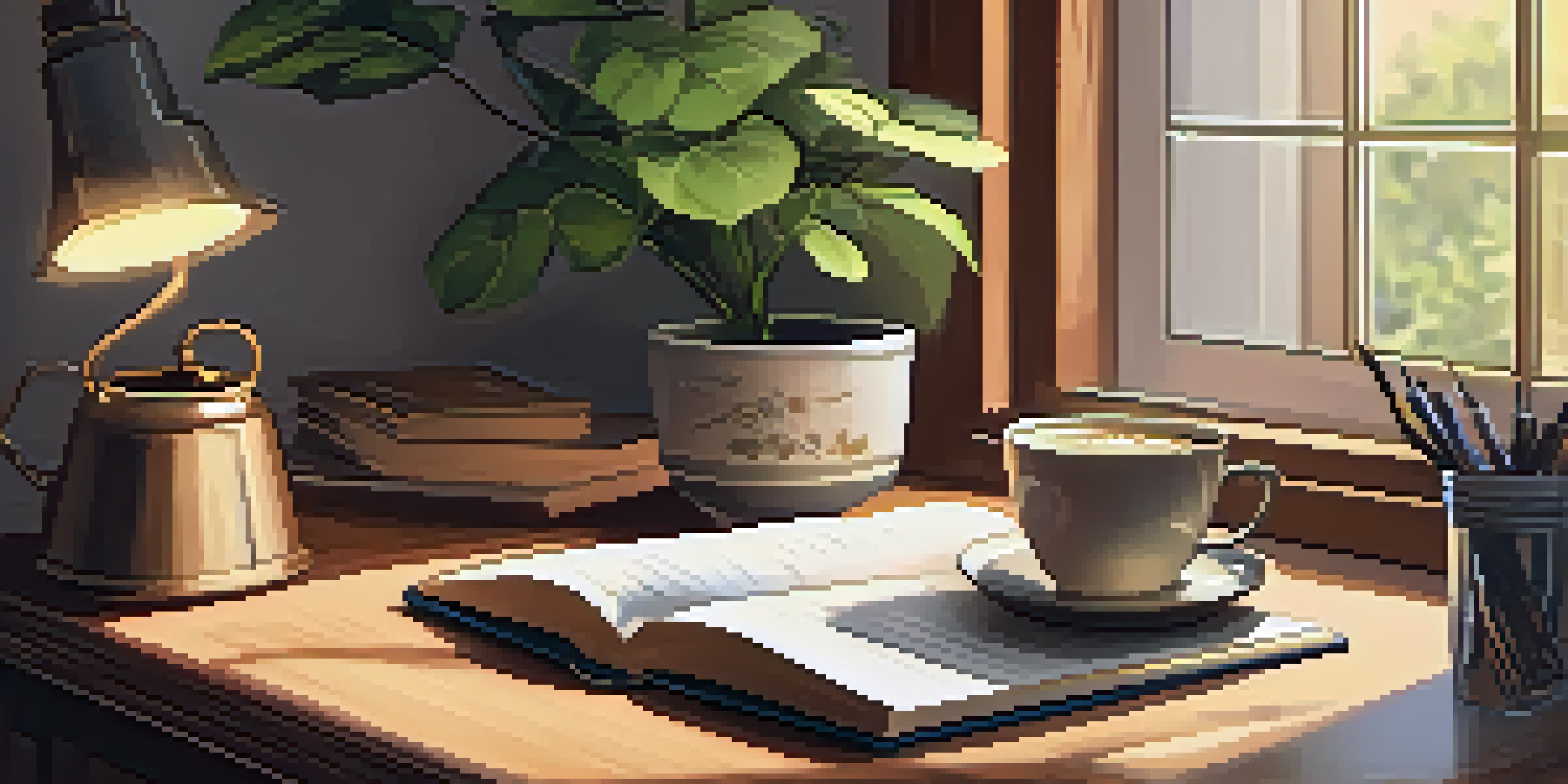Daily Journaling: A Method to Unleash Creative Potential

Understanding the Power of Daily Journaling
Daily journaling is more than just writing down thoughts; it's a gateway to self-discovery and creativity. By putting pen to paper, you can explore your ideas, feelings, and experiences in a structured way. This practice allows you to clarify your thoughts, making it easier to tap into your creative potential.
Journaling is like whispering to one’s self and listening at the same time.
Think of journaling as a conversation with yourself. It’s a safe space where you can express your innermost thoughts without judgment. This freedom can lead to unique insights and inventive ideas that might remain hidden in the bustle of daily life.
Moreover, regular journaling cultivates a habit of reflection. Over time, you may notice patterns in your thinking or recurring themes in your life, which can spark new creative avenues. Understanding these patterns can help you harness your creativity more effectively.
Setting Up Your Journaling Routine
Creating a consistent journaling routine is crucial for reaping its benefits. Start by choosing a specific time each day, whether it’s in the morning with your coffee or at night before bed. This regularity helps signal your brain that it’s time to engage in creative thinking.

You don’t need fancy materials to start journaling; a simple notebook and pen will do. The key is to create a comfortable and inviting space that inspires you to write. This could be a cozy corner in your home or a quiet spot in a local park.
Journaling for Self-Discovery
Daily journaling serves as a safe space for self-expression, leading to unique insights and creative ideas.
Consider setting a timer for 10 to 15 minutes to keep your writing session focused and manageable. This way, you can write freely without feeling overwhelmed, allowing your thoughts to flow naturally and creatively.
Techniques to Enhance Your Journaling Experience
To make the most of your journaling practice, try incorporating different techniques. For instance, free writing—where you write continuously without worrying about grammar or structure—can help unlock your creative flow. This technique encourages spontaneity and can lead to unexpected ideas.
The act of writing is the act of discovering what you believe.
Another effective method is prompt-based journaling. Starting with a specific question or statement can guide your thoughts and inspire deeper reflection. For example, prompts like 'What inspires me today?' or 'What challenges did I overcome this week?' can spark creativity and insight.
Visual journaling is also a fun way to express creativity. If you're inclined towards art, consider doodling, sketching, or using colors alongside your writing. This blend of words and visuals can stimulate your imagination and make your journaling experience more engaging.
Overcoming Common Journaling Barriers
Many people face challenges when starting a journaling practice, such as feeling self-conscious or unsure of what to write. Remember, journaling is a personal journey, and there are no right or wrong ways to do it. Embrace the imperfections; they are part of the process.
You might also struggle with consistency or finding time in your busy schedule. A helpful tip is to keep your journal within reach, perhaps on your bedside table or in your bag. This way, you can seize small pockets of time throughout the day to jot down your thoughts.
Establishing a Routine
Creating a consistent journaling routine helps signal your brain to engage in creative thinking.
If you find yourself staring at a blank page, don’t be afraid to start small. Writing just a sentence or two can ease the pressure. Gradually, you’ll find that the words come more easily, and your creative potential will begin to flourish.
The Benefits of Journaling for Creativity
Daily journaling offers numerous benefits that can significantly enhance your creativity. It serves as a mental decluttering tool, allowing you to organize your thoughts and ideas. This clarity can lead to improved problem-solving and innovative thinking.
Additionally, journaling helps reduce stress and anxiety, creating a more conducive environment for creative pursuits. When your mind is at ease, you’re more likely to explore new ideas and take creative risks.
Furthermore, the act of writing itself can stimulate brain activity, promoting new connections and insights. Many writers and artists attribute their breakthroughs to regular journaling, as it opens up channels of creativity that may otherwise remain dormant.
Incorporating Journaling Into Your Creative Process
To truly unleash your creative potential, find ways to integrate journaling into your broader creative process. For example, use your journal to brainstorm ideas for projects or to outline your goals and aspirations. This practice can serve as a roadmap for your creative journey.
You can also document your creative experiments and reflect on your progress. Noting what works and what doesn’t can help you refine your approach and inspire new directions. This reflective practice can be immensely valuable in nurturing your growth as a creative individual.
Techniques to Boost Creativity
Incorporating techniques like free writing and visual journaling can enhance your creative flow and engagement.
Finally, consider sharing excerpts from your journal with trusted friends or fellow creatives. This exchange can lead to valuable feedback and spark collaborative ideas, further enriching your creative endeavors.
Embracing the Journey of Creativity Through Journaling
Ultimately, journaling is a personal and evolving journey that can profoundly affect your creative potential. It invites you to explore your thoughts and feelings while providing a platform for self-expression. Embracing this journey with an open heart can lead to wonderful discoveries about yourself and your creativity.
Remember, there’s no finish line in creativity; it’s about enjoying the process and learning along the way. Each entry in your journal is a stepping stone toward greater self-awareness and artistic exploration.

So, grab a journal and start writing! Whether it’s stream-of-consciousness thoughts or structured reflections, you’ll find that each page is a canvas for your imagination, waiting to be filled with your unique voice and ideas.